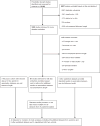Gender and telomere length: systematic review and meta-analysis
- PMID: 24365661
- PMCID: PMC4523138
- DOI: 10.1016/j.exger.2013.12.004
Gender and telomere length: systematic review and meta-analysis
Abstract
Background: It is widely believed that females have longer telomeres than males, although results from studies have been contradictory.
Methods: We carried out a systematic review and meta-analyses to test the hypothesis that in humans, females have longer telomeres than males and that this association becomes stronger with increasing age. Searches were conducted in EMBASE and MEDLINE (by November 2009) and additional datasets were obtained from study investigators. Eligible observational studies measured telomeres for both females and males of any age, had a minimum sample size of 100 and included participants not part of a diseased group. We calculated summary estimates using random-effects meta-analyses. Heterogeneity between studies was investigated using sub-group analysis and meta-regression.
Results: Meta-analyses from 36 cohorts (36,230 participants) showed that on average females had longer telomeres than males (standardised difference in telomere length between females and males 0.090, 95% CI 0.015, 0.166; age-adjusted). There was little evidence that these associations varied by age group (p=1.00) or cell type (p=0.29). However, the size of this difference did vary by measurement methods, with only Southern blot but neither real-time PCR nor Flow-FISH showing a significant difference. This difference was not associated with random measurement error.
Conclusions: Telomere length is longer in females than males, although this difference was not universally found in studies that did not use Southern blot methods. Further research on explanations for the methodological differences is required.
Keywords: Epidemiology; Gender; Measurement methods; Systematic review and meta-analysis; Telomere length.
Copyright © 2013. Published by Elsevier Inc.
Conflict of interest statement
This is an original work, and it has never been published nor is under consideration for publication elsewhere. All the authors have substantially contributed to data collection and manuscript drafting and revision. Peter Lansdorp is a founding shareholder in Repeat Diagnostics, a company specializing in leukocyte telomere length measurements using flow FISH. All other authors have not declared any conflicts of interest.
Figures





References
-
- Adams J, Martin-Ruiz C, Pearce MS, White M, Parker L, von Zglinicki T. No association between socio-economic status and white blood cell telomere length. Aging Cell. 2007;6:125–128. - PubMed
-
- Aubert G, Baerlocher GM, Vulto I, Poon SS, Lansdorp PM. Collapse of telomere homeostasis in hematopoietic cells caused by heterozygous mutations in telomerase genes. PLoS Genet. 2012;8 http://dx.doi.org/10.1371/journal.pgen.1002696. - DOI - PMC - PubMed
-
- Austad SN. Why women live longer than men: sex differences in longevity. Gend Med. 2006;3:79–82. - PubMed
-
- Aviv A. Telomeres, sex, reactive oxygen species, and human cardiovascular aging. J Mol Med. 2002;80:689–695. - PubMed
-
- Aviv A, Valdes AM, Spector TD. Human telomere biology: pitfalls of moving from the laboratory to epidemiology. Int J Epidemiol. 2006;35:1424–1429. - PubMed
Publication types
MeSH terms
Grants and funding
- MC_UP_A620_1015/MRC_/Medical Research Council/United Kingdom
- MR/K023209/1/MRC_/Medical Research Council/United Kingdom
- HL80698/HL/NHLBI NIH HHS/United States
- UL1 RR024156/RR/NCRR NIH HHS/United States
- MC_UP_A620_1014/MRC_/Medical Research Council/United Kingdom
- HHSN268201200036C/HL/NHLBI NIH HHS/United States
- R01 HL080295/HL/NHLBI NIH HHS/United States
- MC_UU_12011/1/MRC_/Medical Research Council/United Kingdom
- N01-HC-95167/HC/NHLBI NIH HHS/United States
- ETM/55/CSO_/Chief Scientist Office/United Kingdom
- CZB/4/505/CSO_/Chief Scientist Office/United Kingdom
- N01 HC085080/HL/NHLBI NIH HHS/United States
- N01-HC-95162/HC/NHLBI NIH HHS/United States
- UL1 RR025005/RR/NCRR NIH HHS/United States
- UL1-RR-025005/RR/NCRR NIH HHS/United States
- U01 HL080295/HL/NHLBI NIH HHS/United States
- N01 HC095169/HL/NHLBI NIH HHS/United States
- N01 HC085082/HL/NHLBI NIH HHS/United States
- MC_UU_12011/2/MRC_/Medical Research Council/United Kingdom
- HHSN268200800007C/HL/NHLBI NIH HHS/United States
- N01-HC-95163/HC/NHLBI NIH HHS/United States
- N01 HC085086/HL/NHLBI NIH HHS/United States
- N01-HC-95168/HC/NHLBI NIH HHS/United States
- N01 HC085083/HL/NHLBI NIH HHS/United States
- UL1-RR-024156/RR/NCRR NIH HHS/United States
- G0500997/MRC_/Medical Research Council/United Kingdom
- N01-HC-95159/HC/NHLBI NIH HHS/United States
- G0601333/MRC_/Medical Research Council/United Kingdom
- N01-HC-95165/HC/NHLBI NIH HHS/United States
- R01 HL080698/HL/NHLBI NIH HHS/United States
- MR/K026992/1/MRC_/Medical Research Council/United Kingdom
- MC_UU_12017/5/MRC_/Medical Research Council/United Kingdom
- N01 HC095159/HL/NHLBI NIH HHS/United States
- SPHSU2/CSO_/Chief Scientist Office/United Kingdom
- N01 HC055222/HL/NHLBI NIH HHS/United States
- N01-HC-95169/HC/NHLBI NIH HHS/United States
- N01-HC-95164/HC/NHLBI NIH HHS/United States
- N01 HC085079/HL/NHLBI NIH HHS/United States
- N01-HC-95160/HC/NHLBI NIH HHS/United States
- G0700704/MRC_/Medical Research Council/United Kingdom
- WT_/Wellcome Trust/United Kingdom
- MR/K007017/1/MRC_/Medical Research Council/United Kingdom
- N01-HC-95161/HC/NHLBI NIH HHS/United States
- HL080295/HL/NHLBI NIH HHS/United States
- BB/F019394/1/BB_/Biotechnology and Biological Sciences Research Council/United Kingdom
- MC_UP_A540_1021/MRC_/Medical Research Council/United Kingdom
- MC_PC_13040/MRC_/Medical Research Council/United Kingdom
- N01-HC-95166/HC/NHLBI NIH HHS/United States
- R01 AG023629/AG/NIA NIH HHS/United States
- AG023629/AG/NIA NIH HHS/United States
- MC_U147585824/MRC_/Medical Research Council/United Kingdom
- R56 AG023629/AG/NIA NIH HHS/United States
- N01 HC085081/HL/NHLBI NIH HHS/United States
- MC_UU_12017/7/MRC_/Medical Research Council/United Kingdom
LinkOut - more resources
Full Text Sources
Other Literature Sources
Medical

